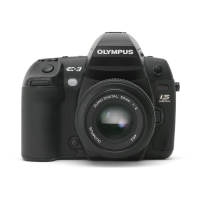148
EN
Information
12
P
(Program) Mode
Also called Program AE mode. The camera automatically sets the best shutter speed and aperture for
the shot.
PictBridge
A standard that enables digital cameras and printers made by different manufacturers to be connected,
and also allows pictures to be printed directly from the camera.
Pixels
A pixel is the smallest unit (dot) used to make up an image. Clear large-sized printed images require
millions of pixels.
RAW
Refers to raw data, data which has not been enhanced with a camera option like white balance,
sharpness, contrast, etc. This file format is for viewing and processing with our own software. You may
not be able to open or process these files with other graphics software applications, and these files
cannot be selected for DPOF printing. RAW files are assigned an orf file extension (*.orf).
S
(Shutter Priority) Mode
Also called Shutter Priority AE mode. The user selects the shutter speed and the camera automatically
varies the aperture so that the picture is taken with the best exposure.
Single-lens reflex camera
A camera that uses the reflective mirror to bend the light entering from the shooting lens and uses the
viewfinder to check. There is no difference between the composition to be captured and the
composition viewed on the viewfinder.
Sleep Mode
A mode designed to save battery life. The camera automatically enters the sleep mode if you do not
operate it for a certain time. To get out of the sleep mode, use any button on the camera (shutter
button, menu button, etc.).
Spot metering
The meter reading is taken from a very small area around the center of the subject, defined by the spot
metering area mark in the viewfinder. Spot metering is ideal for use in difficult light conditions, or when
the important element of the picture (subject’s face) is small. Use spot metering for backlit subjects, or
sports and stage performers. See also digital ESP metering and center weighted averaging metering.
TFT (Thin-Film Transistor) Color Monitor
A color monitor constructed using thin-film technology.
TTL phase-contrast detection system
This is used to measure the distance to the subject. The camera determines if the image is focused by
the detected phase contrast.
TTL (Through-The-Lens) System
To help adjust exposure, a light receptor built into the camera directly measures the light passing
through the lens.

